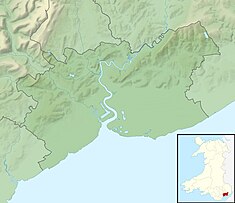Plas Machen
| Plas Machen | |
|---|---|
 Distant view of the house from the Rhymney River circular walk | |
| Type | House |
| Location | Lower Machen, Newport, Wales |
| Coordinates | 51°34′53″N 3°06′21″W / 51.5815°N 3.1059°W |
| Built | 16th century, with earlier and later parts |
| Architectural style(s) | Elizabethan |
Listed Building – Grade II* | |
| Official name | Plas Machen |
| Designated | 3 March 1952 |
| Reference no. | 2905 |
| Official name | Plas Machen Garden |
| Designated | 1 February 2022 |
| Reference no. | PGW(Gt)33(NPT) |
Listed Building – Grade II | |
| Official name | Nos. 1 & 2 Plas Cottages |
| Designated | 18 January 1984 |
| Reference no. | 3070 |
Plas Machen is a country house in the hamlet of Lower Machen, to the west of the city of Newport, Wales. The house was the ancestral home of the Morgan family of South Wales prior to their construction of Tredegar House. It is a Grade II* listed building. The gardens are listed at Grade II on the Cadw/ICOMOS Register of Parks and Gardens of Special Historic Interest in Wales. A pair of cottages in the grounds of the house are also listed at Grade II. The house remains a private residence and is not open to the public.
History[edit]
Morgans of Machen and Tredegar[edit]
The earliest recorded link between the Morgan family of South Wales and Machen is to the building of Plas Machen by "Morgan of Machen who led men of Gwent at Bosworth in 1485".[1] In the following centuries, the family became one of the wealthiest and most powerful in South Wales.[2][3][a] In the 1660s Sir William Morgan (c.1640-1680) rebuilt Tredegar House as the centrepiece of the family's estates in Monmouthshire, Glamorganshire and Brecknockshire.[5] In the 19th century, Sir Charles Morgan was created Baron Tredegar,[6] and in the early 20th century, his son Godfrey was elevated in the peerage as Viscount Tredegar.[7] The viscountcy was revived for his nephew, Courtenay Morgan, in 1926.[8] but became extinct on the death of Courtenay's son, Evan in 1949, after which the family's landholdings in South Wales were sold.[9][10][b]
Plas Machen[edit]
The Royal Commission on the Ancient and Historical Monuments of Wales gives building dates for Plas Machen as the "15th, 16th, 17th centur[ies] and later".[1] Cadw suggests that the house reached its greatest extent in the 1600s, before being superseded by Tredegar House as the family's main residence.[11] It was much reduced in size in the 19th century, before restoration by Habershon and Pite in 1859. The Morgans retained ownership, although they ceased to live at the house by around 1800.[11][c] The house, and some associated barns, were restored in the 21st century.[13]
Architecture and description[edit]
The house is built of rubble stone with brick chimney stacks. Archdeacon Coxe saw the house when it was still complete during a visit in 1800 and recorded his impressions in his two-volume, An Historical Tour in Monmouthshire. Of the interior, Coxe noted a circular room devoted to hunting, with a ceiling centrepiece of the goddess Diana and decorative scenes depicting important local houses and churches, together with hunting images.[11] This was located in part of the house subsequently demolished. The gardens retain their Tudor skeleton,[14] with a series of terraces and axes leading down to a fish pond.[15] While the outline of the formal gardens remains, much has now been returned to pasture.[16]
Plas Machen is a Grade II* listed building.[11] Its gardens and grounds are listed at Grade II on the Cadw/ICOMOS Register of Parks and Gardens of Special Historic Interest in Wales.[15] A pair of cottages also have a Grade II listing.[17]
Notes[edit]
- ^ 14 members of the family are buried in the Morgan Chapel at the Church of St Michael and All Angels in the village of Lower Machen.[4]
- ^ Evan's cousin, John, 6th and last Baron Tredegar, oversaw the sale of the family's landholdings in South Wales, including Tredegar House and Ruperra Castle, dying, a tax exile in Monte Carlo, in 1962.[10]
- ^ An engraving of Plas Machen, dating from around 1800 and showing the house at its fullest extent, is held in the National Trust collection at Tredegar House.[12]
References[edit]
- ^ a b "Plas Machen, Graig (20669)". Coflein. RCAHMW. Retrieved 24 March 2024.
- ^ "Morgan family, of Tredegar Park, Monmouth". Dictionary of Welsh Biography. Retrieved 24 March 2024.
- ^ "History of Tredegar House". National Trust. Retrieved 24 March 2024.
- ^ "St Michael & All Angels". National Churches Trust. Retrieved 24 March 2024.
- ^ Cadw. "Tredegar House (Grade I) (2902)". National Historic Assets of Wales. Retrieved 24 March 2024.
- ^ "No. 22248". The London Gazette. 12 April 1859. p. 1482.
- ^ "No. 27871". The London Gazette. 5 January 1906. p. 107.
- ^ "No. 33190". The London Gazette. 10 August 1926. p. 5288.
- ^ "The Gay Aristocracy of Victorian Wales". Cadw. Retrieved 24 March 2024.
- ^ a b Povey, Tomos (4 November 2017). "The last Lord of Tredegar, who avoided paying millions, sold Tredegar House and lived as a tax exile in Monte Carlo". South Wales Argus. Retrieved 24 March 2024.
- ^ a b c d Cadw. "Plas Machen (Grade II*) (2905)". National Historic Assets of Wales. Retrieved 24 March 2024.
- ^ "Plas Machen (Machen Place) – Item NT1553545". National Trust. Retrieved 24 March 2024.
- ^ "Plas Machen". Andrew Faulkner Associates. Retrieved 24 March 2024.
- ^ "Plas Machen". Parks & Gardens UK. Retrieved 24 March 2024.
- ^ a b Cadw. "Plas Machen (PGW(Gt)33(NPT))". National Historic Assets of Wales. Retrieved 24 March 2024.
- ^ "Plas Machen Garden, Lower Machen (301647)". Coflein. RCAHMW. Retrieved 24 March 2024.
- ^ Cadw. "Nos. 1 & 2 Plas Cottages (Grade II) (3070)". National Historic Assets of Wales. Retrieved 24 March 2024.

